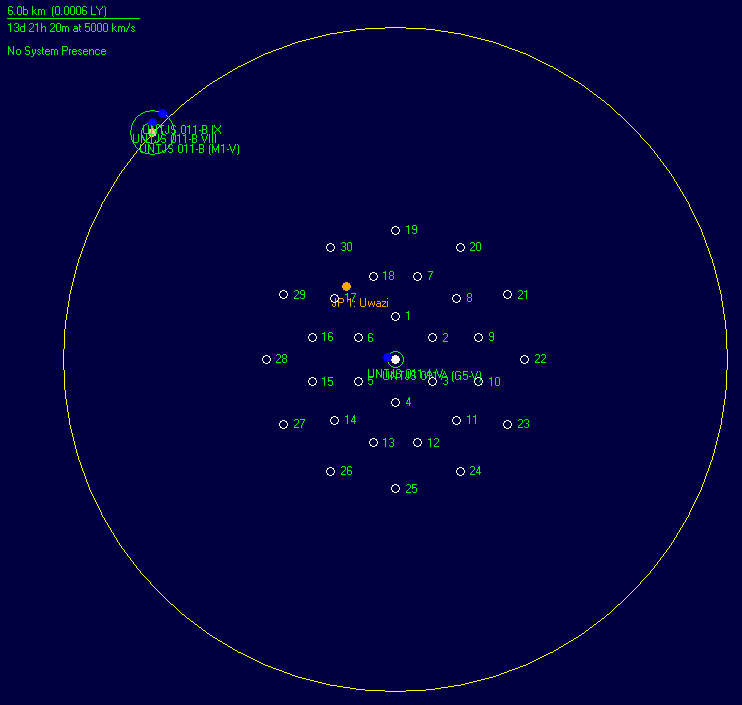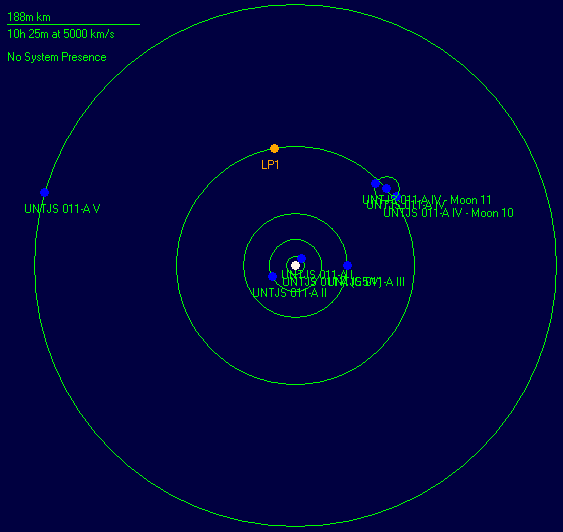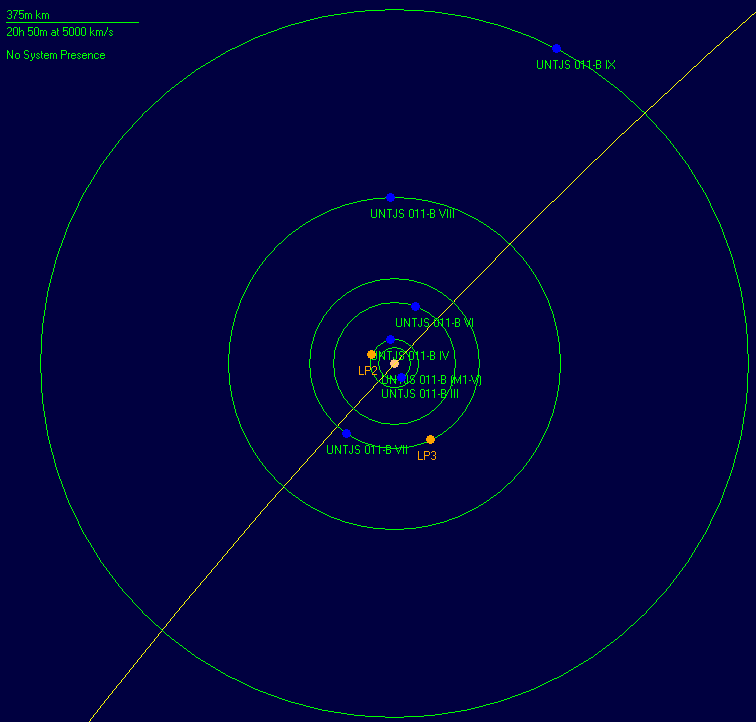Jutland
Link to Systembodies Raw Viwer
Right Ascension: 6h 53' 16.79"
Declination: Dec 8° 0' 36"
Distance: 155 parsecs (507 ly)
Jutland-Fyn, originally designated UNTJS 011, is a UN-claimed binary system connected to the Uwazi crossroads. It consists of a white dwarf primary named Jutland and red dwarf companion named Fyn, both having several planets and moons. Although the stars are 14 billion kilometres apart, a Lagrange jump is possible between the orbiting planets, shortening the travel distance between the stars to less than 1 billion km.
Contents
Geography
Jutland-Fyn is a binary star system located 155 parsecs (507 ly) from Sol in the direction of the constellation Monoceros (RA 6h 53m 16.79s, Dec 8° 0' 36"). The primary is a G5-V yellow dwarf, similar to Sol in radius and mass, but with only about half the luminosity. The primary has a five-member planetary system. Orbiting at 100 AU is a M1-V red dwarf companion star which itself has a planetary system consisting of seven major bodies. The smaller star has only half the radius and mass of Sol and only 4% of Sol's luminosity.
The system's entry point from Uwazi lay beyond the outermost planet of the primary, 4.0b km out at bearing 326°.
Jutland
The planetary system of the primary consists of four terrestrial bodies and a super-jovian gas giant.
- The innermost planet, Jutland I, is a Venusian world about 6% larger in radius and 77% more massive than Earth. These combine to give the world a surface gravity of 1.56g, within human tolerances but rather uncomfortable to operate in until acclimated. A thick (147 atm) atmosphere of carbon dioxide and nitrogen dioxide shroud the body in a thick greenhouse envelope. This, combined with its star-scraping orbit (a semi-major axis of only 13.3m km, orbiting every 9.9 days) means the body has a surface temperature beyond the melting point of lead and it is likely that much of the surface may be semi-molten.
- Jutland II is an airless world orbiting at 36m km from the primary, taking 45 days to complete an orbit. 38% the diameter of Earth and with only 8% the mass, the A II has a surface gravity of 0.576g. However, the scorching temperature of the tidally locked sun side of the planet makes this body a long-shot for colonization.
- The next planet in, Jutland III, is part of an interesting binary planet system. Consisting of two nearly-equal sized planets orbiting 73m km from the primary, convention has the slightly more massive member (48.6% Earth radius, 11.6% Earth mass) designated as Jutland III, while the companion moon (48.1% Earth radius, 11.0% Earth mass), which orbits 502,000 km from A III, is called Jutland III - Moon 1. The two orbit the primary once every 128 days and each other every 116 days, leading to an unusual diurnal cycle. In addition, the larger of the bodies has considerable rotational angular momentum, completing a revolution about its axis once every 96 hours. Neither body has an atmosphere, but both lie within the habitability zone of the system primary. Tidal bulge heating heats A III to an average surface temperature near 67° C, but the "moon" is at a comfortable 18.3° C. This is well within the range of human comfort, meaning this body needs only the 0.1 atm of oxygen (and attendant other gases to dilute the oxygen) to render it perfectly habitable. A III itself would require some form of active cooling (most likely through a soletta and judicious production of anti-greenhouse gas).
- Jutland IV is a large gas-giant, twice as massive as Jupiter, orbiting at 168m km. The planet is massive enough to allow for intra-system jumps between its trailing L-point and those of the super-jovians circling the B component. A IV has a modest moon system consisting of 11 bodies, the last two of which have extremely distant orbits from the planet (17.3m and 18.1m km, respectively). Only three of these moons have sufficient surface gravity to support human colonization: Moon 3 (0.18g), Moon 9 (0.18g), and Moon 10 (0.41g). None of the gas giant's moons contains an atmosphere, and all are too cold to allow ready habitation, although their habitability is somewhat better than pre-terraforming Luna.
- Jutland V is an icy terrestrial world orbiting more than twice as far out (368m km) as A IV. The planet has a radius 22% greater than Earth and a mass more than 50% greater, giving a surface gravity of 0.983g, quite close to Earth-standard. A 1 atm nitrogen/methane atmosphere blankets the planet, and spectographic analysis reveals an enormous, planet-swaddling water ice sheet, making A V one of the only sources of water in the system. The planet has a single small asteroid moon orbiting at 125,000 km.
Fyn
- The companion component's innermost planet, Fyn II, is tidally-locked Venusian planet orbiting at 16.7m km from the red dwarf, completing an orbit (and revolution) once every 20.6 days. Despite being close to Earth in size (88% Earth radius) and mass (74% Earth), the thick (84 atm) CO2/SO2 atmosphere precludes ready colonization, though it may be a good source of minerals.
- Fyn III is an unremarkable terrestrial planet orbiting 45m km from the B component, orbiting once every 91 days and with a day 4.5 Earth Standard days long. A Mars-sized world (radius 42% Earth, mass 0.055% Earth) with a trace atmosphere, the planet orbits too far from its star for human-compatible temperatures, despite having a surface gravity of 0.306g. B III has a relatively large moon for its size which has an interesting orbit: 534,000 km from the planet, it completes one orbit around B III for every two orbits the planet makes around the star.
- The next planet, Fyn IV, is an enormous gas giant, larger even than the super-jovian circling the primary. Weighing in at nearly 8.5 times the mass of Jupiter, this is one of the largest planets known within the UN-discovered systems. It possesses at least 23 moons larger than 20 km in radius, five of which are large enough to have human-compatible surface gravity: moons #12 (0.58g), 14 (0.49g), 16 (0.90g), 19 (0.64g), and 21 (0.12g), which orbit at 1.05m km, 1.43m km, 1.88m km, 5.0m km, and 14.2m km from the planet, respectively.
- Temperatures are below -100° C for all these moons (except Moon #16, as noted below). While Moon #21 is airless, the other four have largely nitrogen atmospheres of 0.34 atm (Moon #12), 0.19 atm (Moon #14), 0.80 atm (Moon #16), and 0.41 atm (Moon #19). Moon #12's atmosphere contains 0.05 atm of oxygen and the moon is half covered in water ice. Moon #14 has a large portion of its atmosphere (~21%) bound up in frozen CO2 deposits on the surface. Moon #16's atmosphere also contains about 0.05 atm of oxygen, and an unknown process (likely tidal heating) has increased its surface temperature compared to its siblings, making it the lowest colonization-cost moon in the B component's planetary system. However, Moon #19 is a close competitor, as the 0.11 atm of oxygen in its atmosphere renders it possible for a human to walk on the surface with only an air warmer and extreme-weather clothing. It is also nearly entirely covered in a water ice sheet.
- Moons #16 and #19 are large worlds, with 81.5% and 91% of Earth's radius and 59.5% and 52.5% of Earth's mass, respectively. Moon #19 has a small ring system.
- Planet Fyn VI is a smaller giant planet, belonging to the class of ice giants and with a mass of about 8.33 Earths. It has a faint ring system and 21 moons over 20 km in radius, though none of the moons has an atmosphere. Two moons possess sufficient surface gravity to place them as colonization options: #17 (0.18g) and #20 (0.27g). Tidal heating warms moon #20's surface, making it a marginally more attractive habitation target than #17.
- Fyn VII is another huge super-jovian gas giant, 7.86 times as massive as Jupiter and orbiting at 239m km. There are seventeen visible moons larger than 20km in radius. Only the #6 moon (0.17g) has tolerable surface gravity, and its frigid surface temperatures relegate it to the bottom of the habitability list for the system.
- Fyn VIII is a more mundane ice giant, with seventeen equally uninhabitable moons, all orbiting 468m km from the dim red B component.
- Fyn IX is a Titan-like world orbiting in the frozen reaches nearly a billion kilometres from the B component. With 91% Earth's radius and 48.8% its mass, it has a surface gravity of 0.349g, making it technically feasible for it to support human settlements. However, 20% of its atmosphere consists of suspended crystals of poisonous, frozen sulphur dioxide suspended in 0.35 atm of hydrogen and helium. Seas and lakes of semi-liquid SO2 cover much of the frigid surface. It has four moons, one of which is nearly a sixth as wide as B IX itself.
System Schematics
Fig. 1: Overview of Jutland-Fyn system showing primary, orbiting companion and companion's planetary system, and schematic view of system jump point survey locations. Note the position of the JP to Uwazi, 4.0b km from the primary.
Fig. 2: Detail of Jutland planetary system. Note the intra-system jump Lagrange point 60° behind the orbital position of Jutland IV. The primary's planetary system would easily fit within the orbit of Jupiter.
Fig. 3: Detail of Fyn planetary system. The intra-system L-points for both of Fyn's super-jovian worlds can be seen. This planetary system is somewhat more spread out than that of the primary.



